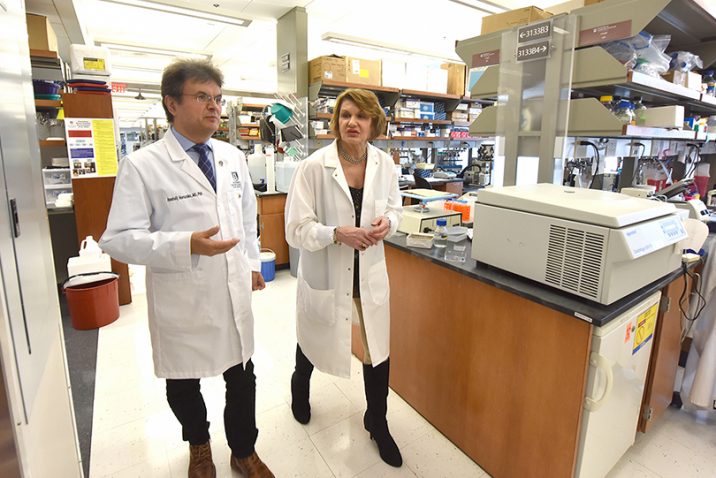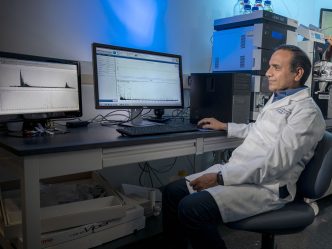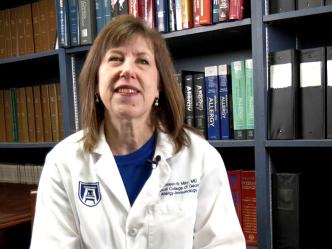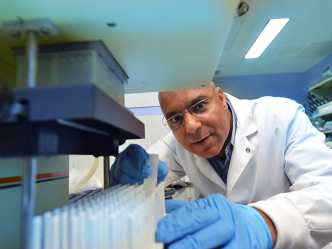Looking to improve organ transplant success, researchers are working to learn more about how an immune molecule, which also protects a fetus, helps protect some transplanted kidneys, and to develop a synthetic version of that molecule that could help more patients.
They also are working from the other direction with a “humanized” mouse model that could better select the optimal organ donor and reduce rejection risk.
The molecule is HLA-G and it’s part of the usual checks and balances that keep our immune system focused on invaders like cancer or a virus and not attacking our own tissue.
Medical College of Georgia investigators, led by Dr. Anatolij Horuzsko, an immunologist in the MCG Department of Medicine and Georgia Cancer Center and a leader in the study of HLA-G, have shown that in the lab and in transplant patients a key difference between many who have long success with a new kidney and those who reject is inexplicably high levels of HLA-G. In this case, it’s a particularly potent version called HLA-G dimer, which is essentially two of the immune molecules bound together.
“We are very interested in the impact of this molecule in the challenge of controlling the immune response to a transplanted organ and in prolongation of graft survival,” says Horuzsko, principal investigator on a $750,000 grant from the Georgia-based Carlos and Marguerite Mason Trust that is enabling pursuit of those interests.
Current projects with longtime colleague and coinvestigator Dr. Laura Mulloy, chief of the Division of Nephrology in the MCG Department of Medicine, include fine-tuning a synthetic version of the super-duper HLA-G they are finding in patients, Horuzsko says. They expect their synthetic HLA-G dimer will one day be added to a patient’s antirejection regimen, possibly even started before the transplant, to provide a more welcoming environment for the new organ, Mulloy says. They also suspect it will enable dose reduction of standard immunosuppressive drugs that generally suppress the immune response and can leave patients vulnerable for other medical problems and infections.
Horuzsko and Mulloy anticipate being ready to move forward with first-in-human trials of the powerful, stable, synthetic HLA-G by the conclusion of the three-year term of their new grant. “Unfortunately it won’t be an immediate answer, but it will be an exciting one,” Mulloy says.
Their pursuits include important details such as whether HLA-G dimer therapy would be needed lifelong, like current transplant drugs, or shorter term. Part of that means seeing how long their synthetic HLA-dimer lasts. The natural version probably lasts for a couple of weeks but people who are good, natural producers of it appear to keep making it, Horuzsko notes.
He also is doing parallel studies to learn more about how the body produces HLA-G to see if production could be induced. They know HLA-G can be induced in some scenarios, for example the fetus apparently spontaneously expresses the molecule to help avoid being targeted by the mother’s immune system because of its “foreign” DNA from the father. They are not certain why it’s naturally high — or when it gets higher — in some transplant patients.
However HLA-G happens, they also want to know more about how it works to protect transplanted organs from rejection.
Horuzsko’s team has shown one way is by inhibiting the activation and destruction of killer T cells. CD8+ cytotoxic T cells are important for attacking viruses and bacteria, but also can attack and destroy transplanted organs, particularly when the match is not ideal. They’ve found patients with naturally high levels of HLA-G dimer tend to have significantly lower levels of granzymes A and B and perforin, all substances used by these killer cells. Perforin essentially makes pores in the cells so granzyme A and B can get in, and they ultimately prompt cell suicide, called apoptosis.
Now they are looking further at how HLA-G dimer interrupts this natural destructive pathway with genomic, molecular and cellular analyses of immune cells from patients as well as mice expressing a human receptor for HLA-G — the most successful transplant patients also tend to have higher levels of HLA-G receptors — and those taking their synthetic HLA-G dimer. They also are looking at gene targets, and have already plotted 17 genes upregulated and 18 downregulated with HLA-G treatment in a humanized model by using the blood of healthy volunteers. “We need to better understand how HLA-G is working,” Horuzsko says.
To further reduce the immune response, they want to fine tune the donor-recipient match with a “humanized” mouse model that has a patient’s immune system to see more directly how it responds to the blood of potential living donors.
The researchers call this new approach an “immunobiological algorithm” and hope that one day all patients and potential donors will have this as part of their frontline evaluation.
As part of the new grant, they have now begun a small trial that compares results from this new approach with the standard evaluation. “We are ready to do this,” Horuzsko says. As part of these early evaluations, a number of “avatar” mice are made for each recipient to enable testing of the blood of multiple potential living donors — a common scenario — and the best combination of immunosuppressive drugs to help them avoid rejection.
Current donor evaluation includes looking to see if there are antigens in the recipient’s blood against proteins on the donor’s blood cells, Mulloy says. HLA, or human leukocyte antigen, which determines what the immune system sees as friend or foe, is examined as part of the donor selection process and only identical twins are likely to have an identical HLA match.
The researchers say their humanized mouse model is more sensitive than even the most sophisticated testing done today called mixed lymphocyte reaction, in which immune cells from two people are combined to see if it prompts activation of T cells, which are drivers of the immune response. It’s also in keeping with trends toward more personalized medicine.
The years of work leading to the new approach include developing a mouse without its own immune system but with growth factors to support human immune cells so a patient’s immune system could be transferred and settle in. Immune cells from the patient needing the new kidney amplify within two or three weeks and the mouse is ready for testing, Horuzsko says, likening the mouse to “an incubator for human immune cells.”
He notes that the humanized mouse model likely cannot be used to better select cadaver donors because of the time it takes for cell amplification and the fact that currently cadaver kidneys typically must be transplanted within 48 hours. Currently about two-thirds of kidney transplants result from cadaver donors, in which a single donor can typically help two patients, according to the National Kidney Foundation. Research indicates that a living donor generally yields the best transplant survival rates.
Kidney rejection rates already are lower now than they have ever been, with one-year survival rates above 95%, but rejection still happens, Mulloy says. Months to years later, recipients can develop chronic rejection, which means their immune system is regularly making cytotoxic killer cells and antibodies against proteins on the donor kidney and eventually the kidney dies.
Even the drugs themselves can directly damage and scar the donor organ, Mulloy says, all good reasons to find the best match and give the minimum drugs necessary.
Cytotoxic cells and antibodies in the blood are often a first sign of trouble. Physicians preemptively look at antibody levels in the blood and for signs of kidney distress like protein in the urine.
Horuzsko and his colleagues first published six years ago evidence from 50 patients with no sign of rejection and 17 with chronic rejection, that those who did well had naturally high levels of HLA-G, a reality that has continued to stand. In 2019, they showed those findings held in 90 patients with a functioning transplanted kidney and 40 individuals who rejected their new organ.
They have also seen that high levels of HLA-G dimer don’t correlate with other common demographics like age, race or gender, rather only with those who do and don’t reject their transplanted organ.
The Mason Trust’s mission is to improve the process of organ transplantation for needy Georgia residents. To date they have given $15.7 million to MCG and Augusta University Health System in support of initiatives like Horuzsko’s. This includes $1.45 million to help fund construction of the Carlos and Marguerite Mason Solid Organ Transplant Center, which opened in April 2017. And, most recently a $215,000 gift in support of telehealth initiatives to enable remote care of patients at the Health System’s Savannah and Albany transplant clinics.
 Augusta University
Augusta University





